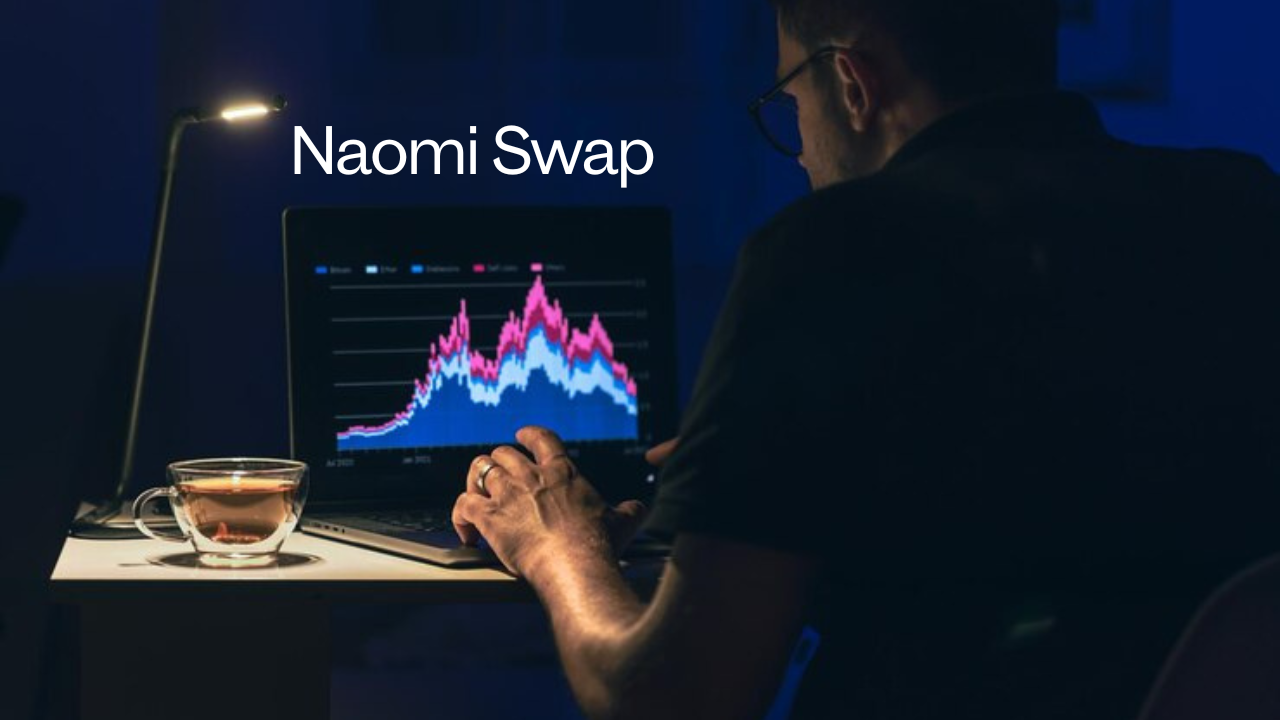What is Naomi Swap?
Naomi Swap is a decentralized finance (DeFi) platform that facilitates seamless token swapping, liquidity provision, and other DeFi functionalities. Unlike centralized exchanges, Naomi Swap operates on a decentralized network, meaning that users retain full control over their assets, without relying on a third-party intermediary. The platform aims to provide an intuitive and secure environment for swapping cryptocurrencies while minimizing costs and maximizing efficiency.
By utilizing automated market makers (AMMs), Naomi Swap allows users to swap tokens directly from their wallets without the need for a traditional order book. This eliminates the need for an intermediary and ensures that all transactions are executed based on supply and demand dynamics within the liquidity pools.
The Technology Behind Naomi Swap
At its core, Naomi Swap leverages blockchain technology, particularly smart contracts, to facilitate token swaps. Smart contracts are self-executing agreements with the terms of the contract directly written into lines of code. These contracts automatically execute when predefined conditions are met, ensuring transparency, security, and immutability of transactions.
Naomi Swap utilizes a decentralized exchange (DEX) model, where liquidity providers (LPs) contribute assets to liquidity pools, enabling users to swap tokens efficiently. The platform’s tokenomics and smart contract architecture ensure that every user transaction is executed securely, with minimal fees and maximum efficiency.
Key Features of Naomi Swap
Naomi Swap offers several key features that make it an attractive option for users seeking to engage in DeFi activities:
- Token Swapping: Users can quickly and easily swap various cryptocurrencies without the need for a centralized exchange.
- Liquidity Pools: Liquidity providers can contribute assets to pools, earning a portion of the transaction fees as rewards.
- Yield Farming: Naomi Swap allows users to earn rewards through yield farming by staking tokens in liquidity pools.
- Staking and Governance: Users can stake Naomi Swap’s native tokens to participate in governance decisions and earn rewards.
- Cross-Chain Compatibility: The platform supports token swaps across multiple blockchains, allowing users to access a wide range of assets.
2. How Does Naomi Swap Work?
Understanding the Mechanism
Naomi Swap operates as a decentralized exchange (DEX) using an automated market maker (AMM) model. In a traditional centralized exchange, buyers and sellers create orders, and an order book matches these transactions. However, in the AMM model, users swap tokens directly from liquidity pools, where the liquidity is provided by other users. These liquidity pools are managed by smart contracts that automatically adjust prices based on supply and demand, ensuring fair and efficient trading.
Liquidity Pools and Automated Market Makers (AMMs)
The concept of liquidity pools is fundamental to the functioning of Naomi Swap. A liquidity pool is a collection of tokens locked in a smart contract that facilitates trading on the platform. These pools are populated by liquidity providers (LPs), who contribute their assets in exchange for a share of the transaction fees.
AMMs, like those used in Naomi Swap, rely on algorithms to determine the price of assets in the pool. The most common pricing algorithm is the constant product market maker (CPMM), which ensures that the product of the two assets in the pool remains constant. This model allows for decentralized trading without the need for an order book or centralized authority.
Tokenomics of Naomi Swap
The tokenomics of Naomi Swap play a crucial role in ensuring the platform’s sustainability and growth. The native token of Naomi Swap, often referred to as NAOMI, is used for various purposes, including governance, staking, and fee payments. Here are some key aspects of Naomi Swap’s tokenomics:
- Governance: NAOMI token holders have voting power on important platform decisions, such as protocol upgrades, fee adjustments, and other key parameters.
- Staking: Users can stake NAOMI tokens to earn rewards, participate in liquidity provision, and support the platform’s growth.
- Transaction Fees: Transaction fees on Naomi Swap are typically lower than those on centralized exchanges, which is one of the platform’s key selling points.
3. The Benefits of Naomi Swap
Low Transaction Fees
One of the most significant advantages of Naomi Swap is its low transaction fees. Since it is a decentralized platform, there is no need for intermediaries to facilitate trades, which results in lower fees compared to centralized exchanges. Additionally, the platform’s use of automated market makers ensures that transaction fees are distributed fairly among liquidity providers.
Decentralized and Trustless Nature
Naomi Swap operates on a decentralized network, meaning that users do not need to trust a third party to execute their transactions. This trustless environment ensures that users retain control over their assets, reducing the risks associated with centralized platforms, such as hacking, fraud, or mismanagement of funds. Transactions on Naomi Swap are executed directly from user wallets through smart contracts, ensuring security and transparency.
Enhanced Privacy and Security
Unlike centralized exchanges that require users to provide personal information for account verification, Naomi Swap allows users to trade tokens anonymously. All transactions are conducted using public keys, and users retain full control over their private keys. This enhanced privacy feature makes Naomi Swap an attractive option for those who value discretion in their financial activities.
Community Governance
Naomi Swap is governed by its community, with NAOMI token holders having the ability to propose and vote on changes to the platform. This decentralized governance model ensures that decisions are made collectively, rather than by a centralized authority. As a result, Naomi Swap aligns with the ethos of decentralized finance and empowers users to shape the future of the platform.
4. Risks and Challenges of Naomi Swap
Impermanent Loss
One of the risks associated with providing liquidity to Naomi Swa pools is impermanent loss. This occurs when the value of the assets in a liquidity pool changes relative to one another, causing LPs to lose potential gains. Although liquidity providers earn transaction fees as compensation, impermanent loss can still occur if the price of the tokens in the pool fluctuates significantly. This risk is inherent in AMM-based platforms like Naomi Swap.
Security Vulnerabilities
While Naom Swap uses blockchain technology and smart contracts to ensure security, it is not immune to security vulnerabilities. Smart contract bugs or flaws can lead to exploits, which could result in the loss of funds for users. As such, it is essential for users to conduct due diligence and understand the risks before interacting with the platform.
Regulatory Uncertainty
The decentralized nature of Naomi Swap can lead to regulatory challenges. As governments around the world continue to develop regulations for the DeFi space, platforms like Naomi Swap may face scrutiny or legal hurdles. The lack of a central authority can make it difficult to comply with traditional financial regulations, which could impact the platform’s long-term viability.
5. The Role of Naomi Swap in DeFi
Facilitating Token Swaps
Naomi Swap plays a crucial role in the DeFi ecosystem by providing a platform for users to swap tokens directly from their wallets. This is made possible by liquidity pools, which facilitate trades based on supply and demand. The platform allows users to access a wide variety of tokens, providing liquidity to the broader DeFi ecosystem.
Providing Liquidity for Other Protocols
By contributing to liquidity pools, Na omi Swap helps provide liquidity for other DeFi protocols. These protocols rely on the availability of assets for lending, borrowing, or other financial activities. Naomi Swap’s role in supplying liquidity makes it an integral part of the broader DeFi infrastructure.
Encouraging Decentralized Finance Innovation
Na omi Swap is a prime example of the innovation happening within the DeFi space. By providing a decentralized and trustless platform for token swapping, liquidity provision, and governance, Nao mi Swap helps promote the principles of DeFi. The platform empowers users to take control of their financial activities without relying on traditional intermediaries.
6. How to Use Naomi Swap
Setting Up a Wallet
To start using Navomi Swap, you’ll need a cryptocurrency wallet that supports the platform. Popular options include MetaMask, Trust Wallet, and Coinbase Wallet. Once you have a wallet set up, ensure it is connected to the Ethereum network or the relevant blockchain network that Na omi Swap supports.
Adding Liquidity to Naomi Swap
To provide liquidity to , you’ll need to deposit an equal value of two tokens into a liquidity pool. In return, you will receive liquidity pool (LP) tokens that represent your share of the pool. As a liquidity provider, you’ll earn a portion of the transaction fees generated by the pool.
Conducting Token Swaps
To swap tokens, simply navigate to the token swap section of the Naomi Swap platform, select the tokens you wish to exchange, and input the amount. The platform will automatically calculate the exchange rate based on the liquidity pool. Confirm the transaction, and the tokens will be swapped instantly
7. Future of Naomi Swap
Roadmap and Upcoming Developments
has an ambitious roadmap that includes new features, partnerships, and blockchain integrations. Future developments may include support for additional blockchains, enhanced user interfaces, and further optimizations to liquidity pools.
Naomi Swap’s Position in the DeFi Ecosystem
Naomi Swap is positioned to be a key player in the DeFi ecosystem, offering a decentralized, low-fee platform for token swapping and liquidity provision. As the DeFi space continues to grow, will likely expand its functionality and user base, further solidifying its place in the market.
Challenges and Opportunities Ahead
While has the potential to thrive in the DeFi space, it will face challenges related to competition, regulatory concerns, and security. However, these challenges also present opportunities for growth and innovation as the platform adapts to meet the needs of the DeFi community.
8. Frequently Asked Questions (FAQs)
What is the Difference Between Naomi Swap and Other DeFi Protocols?
Naomi Swap differentiates itself from other DeFi protocols by offering a seamless and low-cost token swapping experience. Unlike centralized exchanges, Naomi Swap is fully decentralized, providing users with greater privacy and control over their assets.
Is Naomi Swap Safe to Use?
While utilizes blockchain technology and smart contracts to ensure security, users should be aware of the risks associated with impermanent loss and potential smart contract vulnerabilities. It is always recommended to do your own research and exercise caution.
How Can I Earn Rewards with Naomi Swap?
Users can earn rewards on by providing liquidity to the platform’s pools or by staking the platform’s native tokens. Transaction fees and yield farming rewards are distributed among liquidity providers based on their share of the pool.
What Cryptocurrencies Does Naomi Swap Support?
Naomi Swap supports a wide variety of cryptocurrencies, including popular tokens like ETH, DAI, USDC, and other ERC-20 tokens. The platform may expand its support for other blockchains in the future.
Conclusion
Naomi Swap represents an exciting advancement in the decentralized finance (DeFi) space, offering a platform for token swapping, liquidity provision, and governance without relying on centralized intermediaries. With its unique blend of low transaction fees, enhanced privacy, and the ability to earn rewards through liquidity provision has positioned itself as a strong player in the DeFi ecosystem.
Its trustless and decentralized nature ensures users retain control over their assets, fostering transparency and security in every transaction. The integration of automated market makers (AMMs) allows for seamless trades, while its focus on community governance empowers users to shape the platform’s future.
Despite its promising potential, does come with inherent risks such as impermanent loss, security vulnerabilities, and regulatory uncertainty. Users must remain vigilant and informed to fully understand and manage these risks.
Looking ahead roadmap promises further innovations, including the potential for cross-chain compatibility and expanded functionality, solidifying its position in the growing DeFi landscape. While it faces competition from other DeFi protocols, its unique features and commitment to decentralization may allow it to continue thriving in a rapidly evolving space.
For those interested in participating in the DeFi revolution, offers a user-friendly, efficient, and secure option, making it a promising choice for individuals looking to engage in token swaps and liquidity provision.










